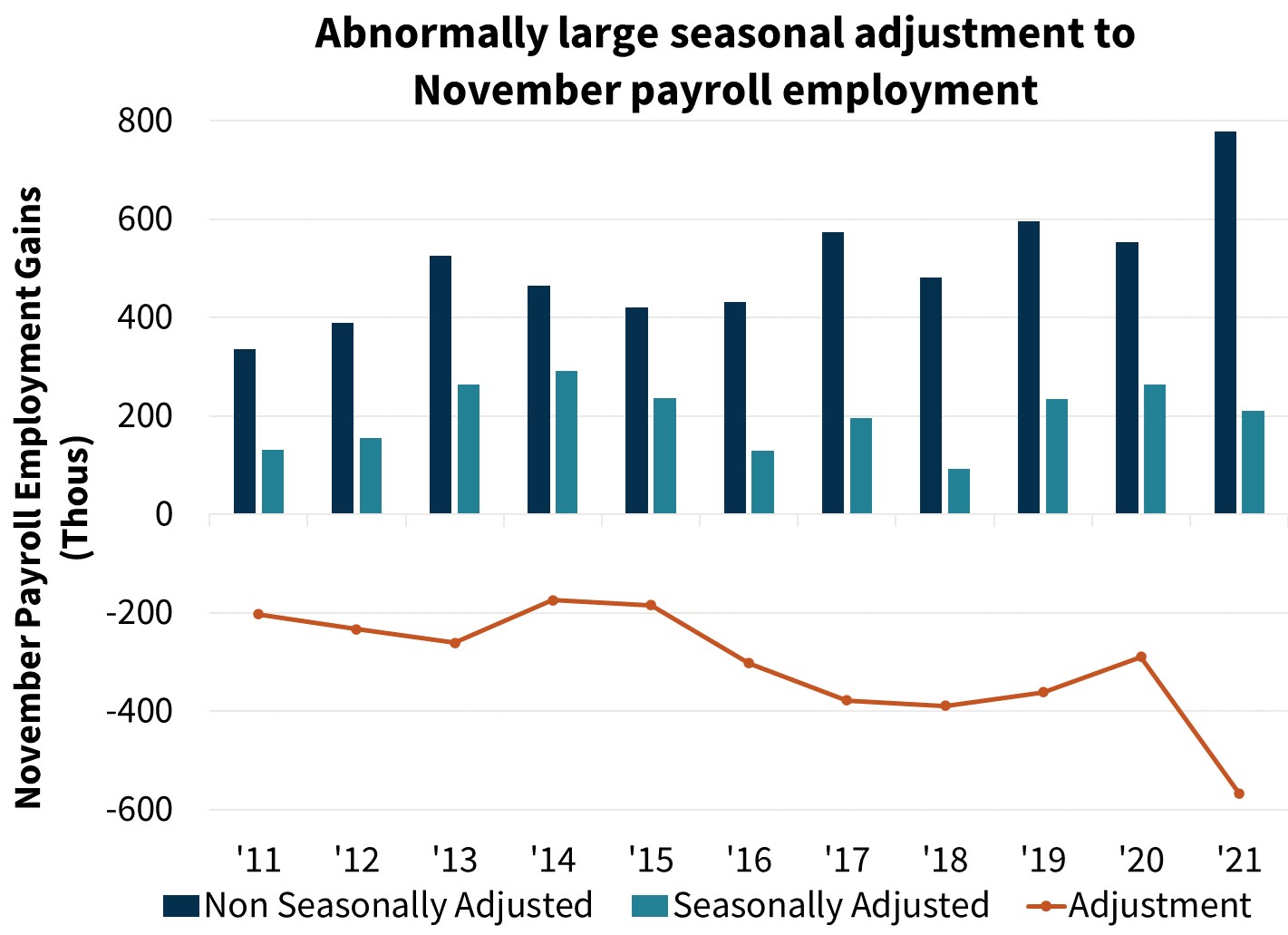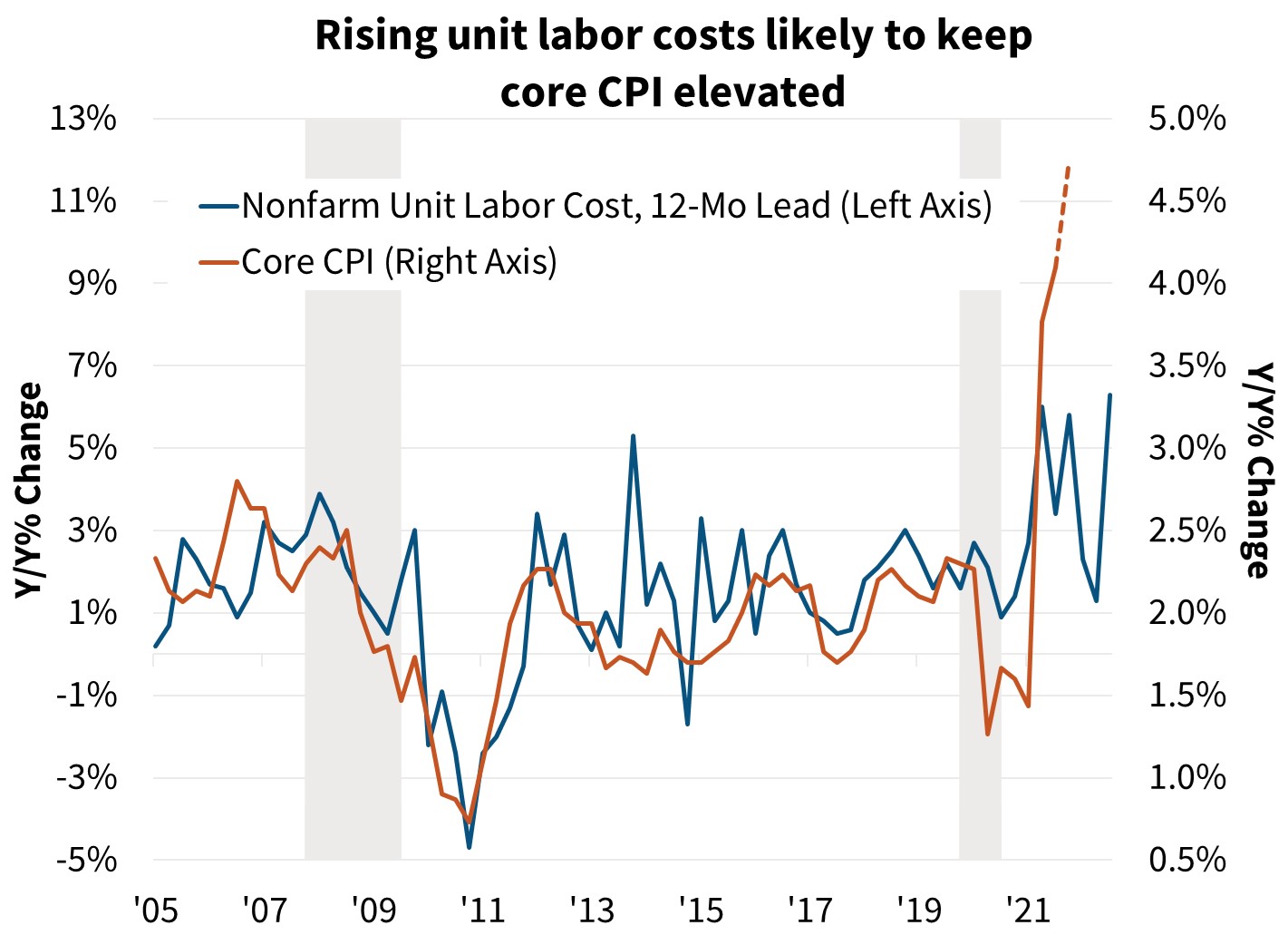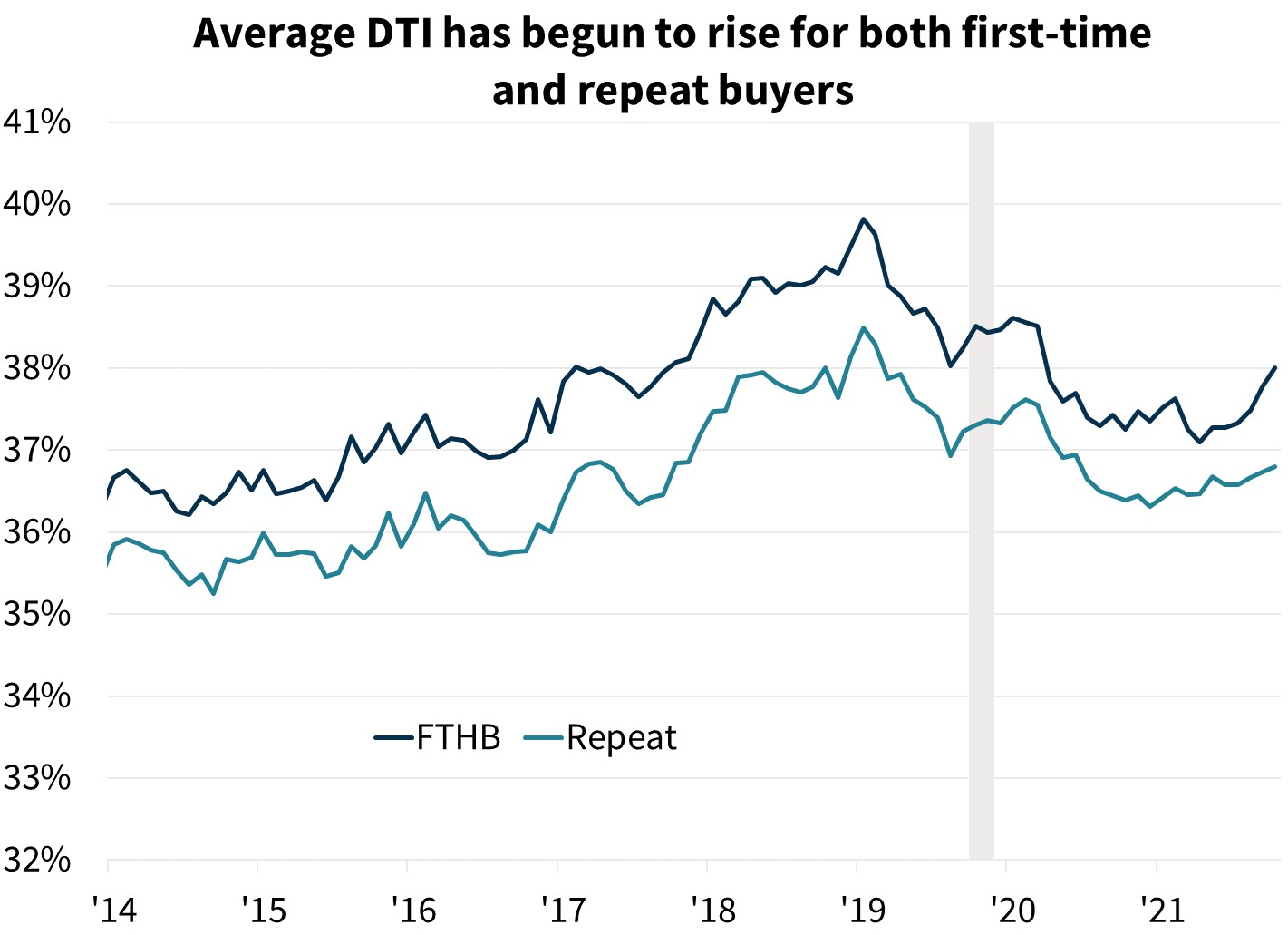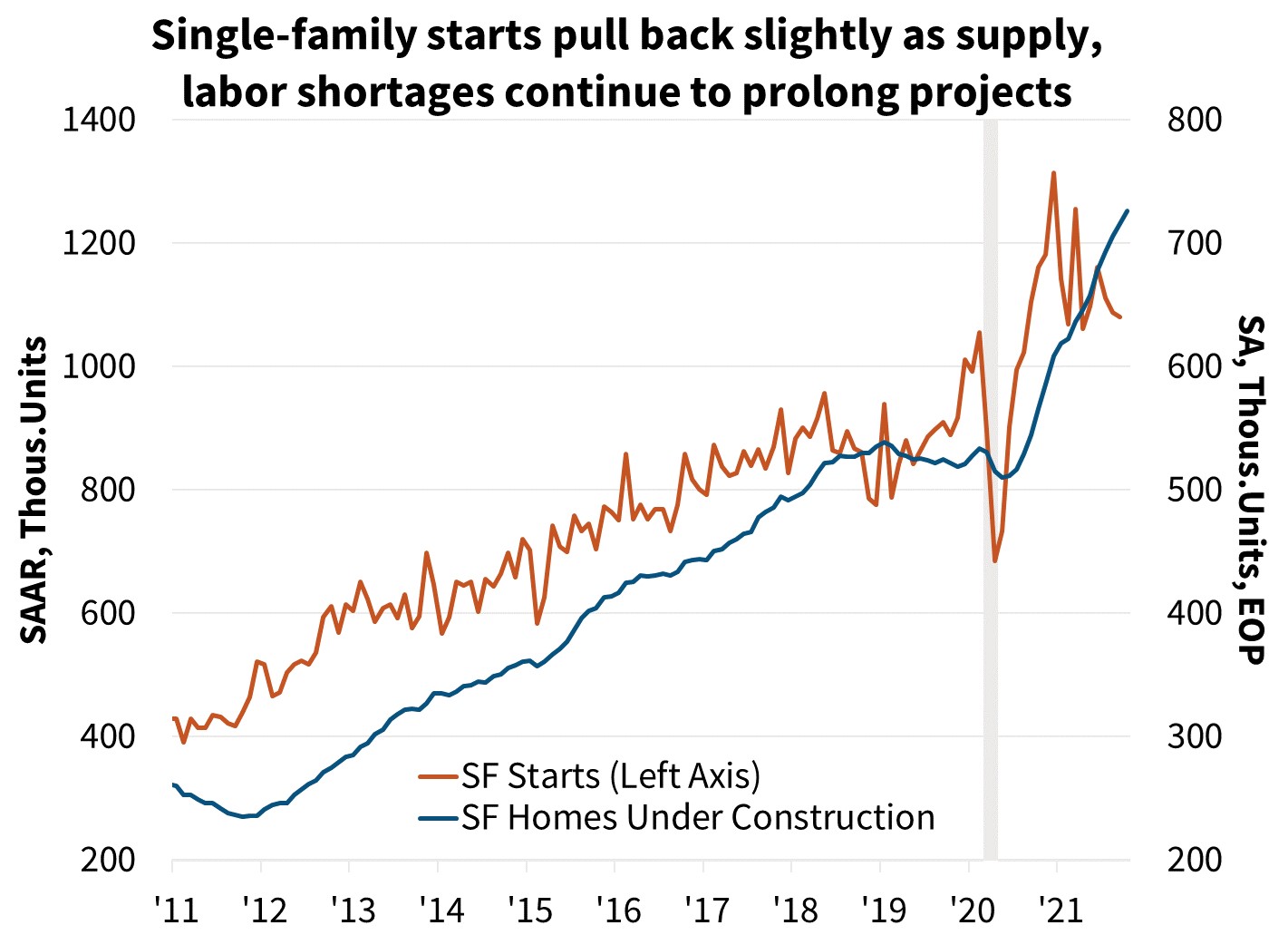Our forecast for 2021 real GDP as measured on a Q4/Q4 basis was revised upward to 5.5 percent from 4.8 percent. Because we believe this greater strength partially reflects the pulling forward of output growth from next year, we have revised downward our 2022 growth forecast to 3.2 percent from a previous 3.7 percent. Incoming data point to both economic growth and home sales finishing 2021 much stronger than we had previously anticipated. We continue to expect both to decelerate, but our prior call on the timing appears to have been premature.
Total home sales, driven by a late-year surge in the sale of existing homes, are now expected to rise 7.1 percent in 2021 compared to our prior projection of a 5.3 percent increase. Home sales are forecast to soften next year, declining slightly by 1.4 percent with limited listings and affordability becoming growing constraints for buyers, and then by another 3.8 percent in 2023. This updated sales forecast, combined with a slightly lower mortgage rate projection, led to an upward revision for total mortgage originations. We now expect total originations in 2021 to be $4.5 trillion, up from a prior forecast of $4.4 trillion. For 2022 and 2023, originations are expected to be $3.4 trillion and $3.1 trillion, respectively, representing an $86 billion upward revision for 2022 and a minimal change to 2023.
Accelerating inflation and both market and policymaker responses to it pose a significant risk to our outlook. Price gains are now likely weighing on consumer spending and are expected to prompt a more aggressive pace of Federal Reserve tightening. During this period of monetary policy transition, long-run interest rates could move significantly in either direction depending on market perceptions of how successful monetary and fiscal policy will be at containing inflation without excessively slowing growth. Rate uncertainty is therefore a major risk. The November Consumer Price Index (CPI) showed annual inflation hitting 6.8 percent, the highest in 39 years. We project it to average 7.0 percent in Q1 2022 before decelerating to 3.8 percent by the end of 2022 under our forecast path of monetary policy. The Fed’s preferred measure, the core PCE deflator, is expected to average 4.8 percent annually in Q1, well above the long-term target of 2 percent. We now expect 25 basis point Fed interest rate hikes in the second and fourth quarters of 2022 and continuing quarterly through 2023. We believe there to be risk of a more aggressive tightening if inflation fails to decelerate in coming months due to supply chain issues taking longer to resolve, consumer spending remaining more robust, or if energy prices spike relative to our expectations.
Our forecast assumes that the Omicron variant of COVID-19 will have minimal economic impact, as preliminary data from abroad appears to indicate less symptom severity compared to the Delta variant, and consumer behavioral responses to COVID waves have diminished over time. Still, future developments remain a risk. Additionally, we have not incorporated the current fiscal package being debated in Congress due to uncertainty over details and timing.
Growth to End Year on a High Note but Will Decelerate in 2022
Our forecast for Q4 2021 GDP was revised upward to 6.9 percent annualized from 4.3 percent. This is a large acceleration from the 2.1 percent annualized growth seen in Q3, and we expect it to be the near-term peak before decelerating next quarter. Real personal consumption spending was considerably stronger in October than we had expected, rising 8.7 percent month-over-month on an annualized basis. While some of this strength likely represents an earlier than typical holiday shopping season, meaning some of that growth will be given back in November, strong quarterly consumption growth is already baked into the Q4 GDP number. The personal saving rate is now at a level modestly below the pre-COVID normal. Households continue to have an elevated stock of savings built up over the past two years, as well as increasing home equity, which could drive faster consumption growth. However, the pace of spending is now eclipsing income growth, while consumer confidence measures remain depressed on inflation concerns. Together, these suggest a meaningful deceleration in consumer spending is coming. We expect personal consumption growth to slow early next year, but in the event that it does not, given ongoing supply constraints, we would expect this to lead to even stronger inflation.
Business inventory investment, which we have long seen as being a major driver of future growth, appears to be making a larger impact sooner than we had expected. Both manufacturer and wholesaler inventories made solid gains in the most recent reports. Auto dealers’ stocks continue to weigh on retail inventories, but even this troubled sector looks to have turned the corner as auto production jumped 11.0 percent in October as previously shuttered plants reopened. While supply chain issues persist, factory and wholesaler shipments are now rising at a sufficient pace that firms can build inventories. While a boon to short-term GDP, rebuilding inventories more quickly than we previously expected means weaker GDP growth than previously anticipated next year. Relatedly, we expect a short-term jump in business fixed investment early next year in part due to equipment shipments being made. Lastly, net exports will likely experience a onetime jump in Q4, reflecting a recovery in refining as well as oil and gas production following Hurricane Ida-related disruptions in Q3.

While the November labor report showed a disappointing slowdown in payroll growth, adding only 210,000 jobs when about 500,000 were expected, we are largely discounting this softness as a data anomaly. We believe the previously mentioned atypical holiday spending pattern this year likely drove the unusually large negative seasonal adjustment over the month. Furthermore, the household survey showed a much stronger employment gain with the unemployment rate falling 0.4 points over the month to 4.2 percent with the labor force participation rate moving up two-tenths to 62.8 percent, the highest level since March 2020. We therefore expect payroll employment to rebound going forward.
Inflation and Monetary Policy to Weigh Heavily Next Year
The November CPI rose briskly for the second consecutive month, accelerating at the fastest annual rate since 1982 as it rose 0.8 percent over the month. While in line with our expectations, the underlying details continue to illustrate broadening inflationary pressure as most categories showed strong gains. Core prices rose by a lesser 0.5 percent, but this still translates to a strong annualized pace of 6.6 percent.

Additionally, the Q3 productivity report showed that unit labor costs (the ratio of the price of an hour of labor to the output value of that hour) rose by a swift 9.6 percent on an annualized basis. While this measure is notoriously volatile, it’s increasingly clear that it is trending significantly higher than what was typical pre-COVID, up 6.3 percent from a year prior compared to a pre-COVID norm of near 2.0 percent. This measure correlates well to the core CPI; current levels suggest that even in the absence of industry-specific supply chain issues driving much of the current inflation, underlying price pressures from labor market dynamics would still leave core inflation a little over 3 percent. With job openings jumping again in October, and the quits level remaining historically high, it is likely that these wage pressures will persist or even accelerate further. In fact, a recent survey of businesses conducted by the Conference Board indicated that firms budgeted employee payroll expenses for next year jumped 3.9 percent, the fastest increase since 2008 and up from 3.0 percent in 2021. They also note that 2021 payroll expense eclipsed last year’s anticipated amount due to higher costs for new hires. Combined with ongoing acceleration in shelter costs, wage pressures are increasingly pointing towards the establishment of a more permanent and elevated inflation level.
The Federal Reserve has now acknowledged this dynamic as Chairman Powell in recent Congressional testimony stated that “transitory” should no longer be used to describe the current inflation situation while also saying that it was “appropriate to consider wrapping up the taper of our asset purchases… perhaps a few months sooner.” Our baseline forecast is one in which the Fed can orchestrate a “soft landing,” where both growth and inflation slow (though the latter remains above trend) but not so much that the expansion is derailed. This is anything but certain. This delicate balancing act has historically been difficult to achieve. There is significant risk to the near-term path of inflation itself. Encouraged by developments in inventory restocking and supply chain issues beginning to be resolved in auto manufacturing, we expect durable goods price inflation to moderate significantly in the first half of next year with some price declines occurring thereafter. We are also assuming that energy prices only rebound modestly as initial Omicron worries fade, followed by some softening of prices as more supply comes online. However, it’s difficult to know when durable goods price increases will end, and our reading of energy market analysts is that there is an abnormally large variance in views on future oil and gas price paths. Our baseline inflation forecast expects the CPI to top out on an annual basis at a little above 7.0 percent in the first quarter 2022. But if supply chain issues persist for longer than we expect, an additional energy spike occurs due to minimal additional supply coming online, and wage pressures accelerate an inflation rate above 8 or even 9 percent by the end of Q2 2022 is plausible.
The longer heightened inflation persists, the greater the pressure will be on the Fed to aggressively tighten policy, providing another level of risk. The market knows the Fed wants long-term inflation expectations to remain well anchored and will monitor long-term interest rates’ reflection of those expectations as a measure of the Fed’s policy effectiveness. If the market perceives that the Fed must act more aggressively and, as a consequence, the risk of recession rises, past market response has included a price correction across financial assets and flight to quality in Treasuries. Therefore, the inflation picture and financial market expectations point toward a potentially turbulent upcoming year with meaningful implications for both the economy and housing.
Housing Affordability Will Increasingly Be a Limiting Factor
Existing home sales moved upward by 0.8 percent in October to an annualized pace of 6.34 million annualized units, while pending sales (which lead closings on average between 30 and 45 days) jumped 7.5 percent. Purchase mortgage applications have also trended up. Other near-term metrics, such as average days from listing to contract signing and the ratio of sale-to-list price, have recently reversed their previous softening. Measures from Redfin and the National Association of Home Builders both show upticks in recent homebuyer traffic as well. This strength may be due in part to some homebuyers anticipating higher mortgage rates and moving their plans forward to lock in lower rates. Together these indictors lead to a projection of stronger near-term sales than what we had previously expected. As such, we have made a large upward revision to our Q4 2021 and Q1 2022 existing sales forecasts, with smaller adjustments thereafter. We now expect Q4 existing sales to be 6.38 million annualized units, the fastest quarterly pace since Q4 2020. We still believe this to be unsustainable as the flow of new listings remains well below the pace of sales, along with the likelihood that a lot of temporary demand drivers should moderate, but we were previously clearly off on the timing of this turn.

While the current limiting factor to home sales is the lack of listings available, we expect continuing strong house price appreciation combined with upwardly drifting mortgage rates to increasingly make affordability the more binding constraint next year. Up until now, homebuyer demand has been in part bolstered by higher-income renters becoming first-time home buyers. This was likely aided by the successive rounds of stimulus checks helping bolster down payments. However, many movers likely pulled forward in time their purchases to take advantage of both low mortgage rates and work arrangement changes due to COVID. Built-up savings from stimulus checks will also diminish over time. Therefore, the pool of borrowers able to afford current high prices is likely shrinking. Aggregating MBS issuance data from Fannie Mae, Freddie Mac, and Ginnie Mae shows that the average back-end debt-to-income ratio (DTI) for first-time homebuyers has started to move up meaningfully through October, suggesting current buyers are increasingly facing affordability pressure. While still low relative to the recent past, a rise in this metric in 2018 foreshadowed a slowdown in sales and house price growth, while regional variation helped explain where the slowdown was greatest. As this indicator rises, we see it similarly pointing to softening purchase demand in 2022 with some of the hotter metro areas of this past year possibly seeing outsized deceleration.
While a constraint on prospective home buyers, high home prices are supportive of home construction, which should lead to more available supply in time. However, homebuilders continue to face labor scarcity and supply chain bottlenecks, both of which are limiting the number of new home sales. The total number of single-family homes under construction moved up again in October to the highest level since May 2007, representing an unprecedented order backlog. Homebuilders continue to report purposely limiting sales due to not being able to keep up with production. While supply problems are likely to persist through next year, we expect more homes to be completed over time, adding to the number of homes on the market and freeing up some capacity of builders to increase their pace of starts. Data on the number of lots under development also point to homebuilders preparing significantly more homes to be made available for sale in 2022. Taken together we expect new home sales to accelerate by mid-2022, coinciding with a modestly faster pace of construction starts. This added new inventory, in conjunction with an affordability-related waning in demand, will help put some downward pressure on home price growth. While we expect continued strong house price appreciation next year of 7.4 percent, as measured by the FHFA index, this represents a significant slowdown from the 16.6 percent price growth we expect for 2021.

Recent multifamily starts data came in near our expectation, so we have only made modest changes to that part of our forecast. We expect continued strength over this next year, despite some moderation from the recent brisk pace, as vacancy rates and rent growth remain supportive.
For more on multifamily market conditions please see the December 2021 Multifamily Market Commentary.
More broadly, uncertainty regarding inflation, monetary policy, and interest rates also have implications for housing activity. A mortgage rate spike due to upwardly adjusting inflation expectations would likely lead to a faster slowdown in sales and price growth. Alternatively, if rates fall on expectations of a growth slowdown, the short run could see a surge in sales activity with a slowdown later in our forecast horizon as economic growth falters.
Mortgage Rates Hold Steady but Could Be Volatile Moving Forward
The ten-year Treasury rate remained volatile in the latter half of November, closing as high as 1.67 percent, then plummeting down to 1.35 percent in early December as the market reacted to both the emergence of the Omicron COVID-19 variant and anticipation of more hawkish-than-expected Fed policy. However, as Omicron fears have waned, yields on the ten-year have risen back to the 1.4-to-1.5 percent range. In contrast, the average yield of a 30-year fixed-rate mortgage over a similar timeframe remained essentially unchanged, sitting at 3.11 percent for the week of December 2, according to Freddie Mac’s Primary Mortgage Market Survey. We are still expecting some drift upward of both the ten-year Treasury and the 30-year mortgage rate, though this month’s forecast includes a modest reduction in the rate path relative to our prior projection. We forecast the 30-year mortgage rate to average 3.2 percent for 2022 and 3.5 percent for 2023. However, the aforementioned uncertainty over the future path of monetary policy and how markets will respond to it leads to a wide range of plausible mortgage rate paths moving forward.
We made relatively small revisions to our forecast for purchase mortgage originations this month, consistent with the revisions to our housing outlook. We now expect 2021 purchase volume to total $1.9 trillion, $13 billion higher than last month’s forecast. We expect volumes to grow 8% in 2022 to $2 trillion, a small upgrade from last month’s forecast. Finally, volumes are expected to be essentially flat in 2023 as rising prices offset slowing home sales.
Our forecast for refinance originations was revised only modestly. We expect 2021 volume to be $2.6 trillion, $27 billion higher than last month’s forecast, driven both by somewhat lower expectation for interest rates as well as recent data on applications. We have also revised upward our 2022 forecast by $49 billion to $1.3 trillion, as the lower mortgage rate forecast boosts volume. Our forecast for 2023 is unchanged. We note that at the current mortgage rate of 3.1 percent, we estimate that about 38 percent of outstanding mortgage balances have at least a 50-basis point incentive to refinance.
Economic & Strategic Research (ESR) Group
December 13, 2021
For a snapshot of macroeconomic and housing data between the monthly forecasts, please read ESR’s Economic and Housing Weekly Notes.
Data sources for charts: Bureau of Labor Statistics, MRS Securitization Disclosure Data, Fannie Mae ESR Analysis, National Association of REALTORS®.
Opinions, analyses, estimates, forecasts and other views of Fannie Mae’s Economic & Strategic Research (ESR) Group included in these materials should not be construed as indicating Fannie Mae’s business prospects or expected results, are based on a number of assumptions, and are subject to change without notice. How this information affects Fannie Mae will depend on many factors. Although the ESR group bases its opinions, analyses, estimates, forecasts and other views on information it considers reliable, it does not guarantee that the information provided in these materials is accurate, current or suitable for any particular purpose. Changes in the assumptions or the information underlying these views could produce materially different results. The analyses, opinions, estimates, forecasts and other views published by the ESR group represent the views of that group as of the date indicated and do not necessarily represent the views of Fannie Mae or its management.